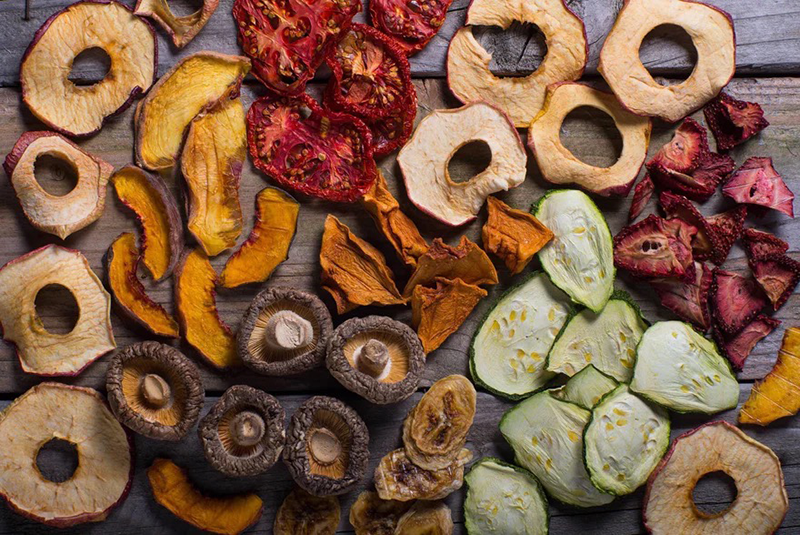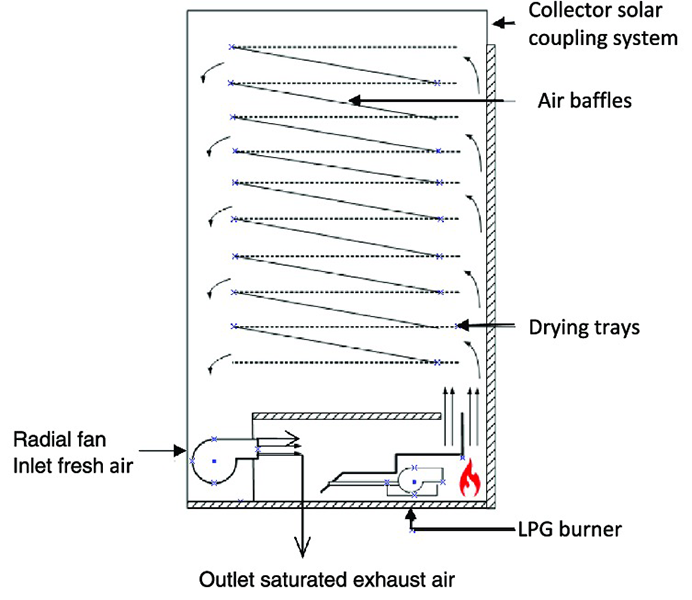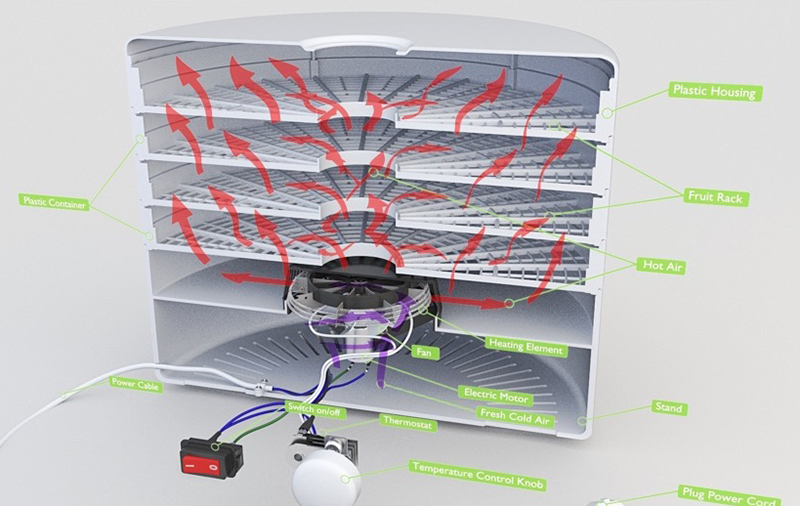
Content Menu
● Understanding Food Dehydration
● How Does a Food Dehydrator Work?
● The Drying Process
● Benefits of Using a Food Dehydrator
● Common Uses of Food Dehydrators
● Tips for Successful Dehydration
● Popular Recipes for Your Dehydrator
>> 1. Apple Cinnamon Fruit Leather
>> 2. Banana Chips
>> 3. Watermelon Jerky
>> 4. Turmeric Kale Chips
>> 5. Dried Mango Slices
● Choosing the Right Food Dehydrator
● Conclusion
● FAQ
>> 1. What types of foods can I dehydrate?
>> 2. How long does it take to dehydrate food?
>> 3. Can I use my oven instead of a dehydrator?
>> 4. How do I know when my food is fully dehydrated?
>> 5. Is it safe to dehydrate meat?
● Citations:
Food dehydrators have become essential kitchen appliances for preserving food, enhancing flavors, and creating healthy snacks. This article will delve into the workings of food dehydrators, their benefits, and practical applications, while also addressing common questions about their use.

Understanding Food Dehydration
Food dehydration is a process that removes moisture from food, preventing the growth of bacteria, yeast, and mold. By reducing the moisture content to between 5% and 20%, dehydrators help extend the shelf life of various foods while retaining their nutritional value and flavor.
How Does a Food Dehydrator Work?
The operation of a food dehydrator can be broken down into several key components:
- Heating Element: The dehydrator contains a heating element that raises the temperature inside the machine. This heat is crucial for evaporating moisture from the food.
- Air Circulation: A fan circulates hot air throughout the dehydrator. This airflow ensures that moisture-laden air is expelled and replaced with dry air, facilitating even drying.
- Trays: Food is placed on trays within the dehydrator. These trays are designed to allow maximum airflow around the food items.
- Temperature Control: Most dehydrators come with adjustable temperature settings, allowing users to select the optimal heat level for different types of food.
The Drying Process
1. Preparation: Before using a dehydrator, food must be prepared appropriately. This may involve washing, slicing, or blanching fruits and vegetables to enhance flavor and texture. For example, soaking apples in a lemon juice solution can prevent browning during dehydration.
2. Loading: Place the prepared food on the trays in a single layer to ensure even drying. Avoid overcrowding the trays to allow proper airflow.
3. Setting Temperature and Time: Depending on the type of food being dried, set the appropriate temperature (usually between 85°F to 160°F) and drying time. Different foods require different settings for optimal results.
4. Monitoring: While most dehydrators operate automatically, it's beneficial to check periodically to ensure even drying and adjust settings if necessary.
5. Storage: Once dried, store the food in airtight containers to maintain freshness. Proper storage is crucial to prevent moisture re-entry and spoilage.

Benefits of Using a Food Dehydrator
- Nutrient Preservation: Dehydrators operate at lower temperatures compared to conventional cooking methods, preserving more nutrients in the food.
- Flavor Enhancement: The dehydration process intensifies flavors, making dried fruits and vegetables taste sweeter and more concentrated.
- Cost-Effective: Dehydrating surplus fruits and vegetables can reduce waste and save money by extending shelf life.
- Versatility: Dehydrators can be used for various foods including fruits, vegetables, meats (like jerky), herbs, and even flowers for tea or decoration.
Common Uses of Food Dehydrators
- Making Snacks: Create healthy snacks like fruit leather, vegetable chips, or beef jerky without preservatives.
- Meal Prep: Prepare ingredients in advance by dehydrating them for later use in soups, stews, or salads.
- Herb Drying: Preserve herbs by drying them for use in cooking or tea.
- Camping Supplies: Lightweight dried foods are perfect for camping trips as they take up less space and weight compared to fresh foods.
Tips for Successful Dehydration
To maximize your dehydrating experience, consider these tips:
- Dehydrate Like Items Together: Group similar foods that require similar drying temperatures together in one batch to ensure uniform drying results[1].
- Cut Uniformly: Ensure that all pieces are cut evenly for consistent drying times. Using a mandoline slicer can help achieve uniform thickness[1].
- Avoid Cross-Contamination: When dehydrating meat alongside fruits or vegetables, dry them separately to prevent cross-contamination[1].
- Rotate Trays: If your dehydrator has multiple trays, rotate them periodically during the drying process to promote even drying[4].
- Check Moisture Levels: After dehydration, ensure that foods are completely dry before storage; sticky or moist items should be returned to the dehydrator[1].
Popular Recipes for Your Dehydrator
Here are some easy recipes you can try with your food dehydrator:
1. Apple Cinnamon Fruit Leather
Ingredients:
- Unsweetened applesauce
- Cinnamon
Instructions:
1. Spread applesauce evenly on a parchment-lined tray.
2. Sprinkle lightly with cinnamon.
3. Dehydrate at 135°F for 8-12 hours until pliable[2].
2. Banana Chips
Ingredients:
- Bananas
Instructions:
1. Thinly slice bananas.
2. Lay slices on trays without overlapping.
3. Dehydrate at 135°F for 10-12 hours until crispy[2].
3. Watermelon Jerky
Ingredients:
- Watermelon
- Lime (optional)
Instructions:
1. Cut watermelon into thin slices.
2. Lay slices on parchment paper.
3. Squeeze lime over slices (optional).
4. Dehydrate at 135°F for 18-24 hours until chewy[2].
4. Turmeric Kale Chips
Ingredients:
- Kale
- Olive oil
- Salt
- Turmeric
Instructions:
1. Tear kale into bite-sized pieces.
2. Massage with olive oil, salt, and turmeric.
3. Lay out on trays.
4. Dehydrate at 135°F for 8-10 hours until crispy[2].
5. Dried Mango Slices
Ingredients:
- Ripe mangoes
- Tajin (optional)
Instructions:
1. Peel and slice mangoes into strips.
2. Lay out on trays; sprinkle with Tajin if desired.
3. Dehydrate at 135°F for 10-12 hours until chewy[2].
Choosing the Right Food Dehydrator
When selecting a food dehydrator, consider factors such as capacity, ease of use, and features:
| Feature | Excalibur 3926T | Nesco FD-1040 Gardenmaster | Cosori Stainless Steel |
| Style | Drawer | Stacking | Stacking |
| Watts | 600 W | 1000 W | 600 W |
| Temperature Range | 105°F - 165°F | 90°F - 160°F | 95°F - 165°F |
| Number of Trays | Up to 9 | Up to 20 | Up to 7 |
| Ease of Cleaning | Moderate | Easy | Very Easy |
The Excalibur model is often favored by serious home cooks due to its durability and large capacity but comes at a higher price point than models like Nesco or Cosori which offer excellent value for beginners[3][6][10].
Conclusion
Food dehydrators are powerful tools that offer numerous benefits for preserving food while maintaining its nutritional value. Understanding how they work allows users to maximize their potential in creating delicious snacks and meals. Whether you are looking to reduce food waste or explore new culinary techniques, investing in a food dehydrator can be a game changer in your kitchen.

FAQ
1. What types of foods can I dehydrate?
You can dehydrate a wide variety of foods including fruits (like apples and bananas), vegetables (such as tomatoes and carrots), meats (for jerky), herbs (like basil and oregano), and even flowers for tea or decoration.
2. How long does it take to dehydrate food?
Dehydration times vary based on the type of food and its thickness. Generally, fruits take about 6-12 hours, vegetables about 4-10 hours, and meats can take up to 12 hours or more depending on thickness.
3. Can I use my oven instead of a dehydrator?
While you can use an oven at low temperatures for dehydration, it is less efficient than a dedicated dehydrator because it may not circulate air as effectively or maintain low temperatures consistently.
4. How do I know when my food is fully dehydrated?
Dried foods should be leathery and pliable but not sticky or moist; they should snap easily when bent if they are vegetables; jerky should be firm but not brittle.
5. Is it safe to dehydrate meat?
Yes! However, it's essential to use proper techniques such as marinating meat beforehand and ensuring it reaches safe internal temperatures during dehydration to prevent bacterial growth.
Citations:
[1] https://www.cnet.com/pictures/tips-for-using-your-new-dehydrator/
[2] https://www.callmelore.com/fool-proof-healthy-dehydrator-recipes/
[3] https://www.treelinereview.com/gearreviews/best-food-dehydrator
[4] https://www.backpackingchef.com/dehydrating-food.html
[5] https://eatsleepwild.com/homemade-dehydrated-backpacking-meals/
[6] https://www.thespruceeats.com/best-food-dehydrators-4077285
[7] https://learn.eartheasy.com/guides/a-beginners-guide-to-dehydrating-food/
[8] https://www.commercialdehydrators.com.au/dehydrating-recipes-filters
[9] https://www.backpackingchef.com/food-dehydrator.html
[10] https://www.seriouseats.com/best-food-dehydrators-5216308











